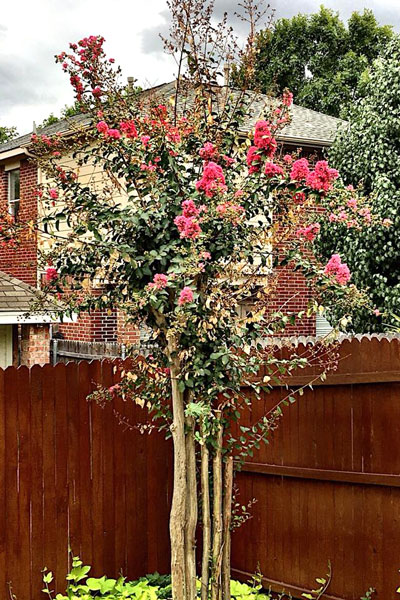Question of the Week – Number 2: August 16, 2018
“What is causing my crape myrtle to die a slow death? It’s losing branches a few at a time. I trim them out and more develop.”
This photo was posted on my Facebook page a week or so ago. I told the FB friend that I had had the same question several times before, and that I’ve seen hundreds of examples of it as I’ve driven around where we live – in the DFW area.

This photo was posted to my FB page a week ago. It was the fourth time I’ve been asked this question in the past several weeks.
This is latent freeze damage that is just now showing up. It’s the result of last winter’s extremely cold weather in January and February, and my bet of this gardener was that it’s the variety Tuscarora. It’s one of the most popular red types, and I’ve seen it showing this type of dieback not only this year, but in several other years over the past 15-20. It’s just not as reliably winter-hardy as most of the rest of the varieties. That also goes for Natchez, Sioux, Muskogee and Country Red. They all got hurt by the cold.
I also saw this happen to a really old Watermelon Red plant in a neighbor’s landscape out in rural Collin County after the winter of 1983-84. That plant was probably 50 years old, and it took it two years to die out completely, but that’s exactly what it did. I don’t think the five varieties I mentioned will do that. The old Watermelon Red plant had been neglected and had suffered from that monumental drought just three years earlier.
If you have a crape myrtle that’s dying back like this, take the plunge. Cut it off at the ground. If there is any oomph left in the plant it will send out vigorous new shoots. They can be trained into becoming the new trunks. Leave 8 or 10 of them for the rest of this year. Next spring thin the number down to 7. Then by the end of next growing season, leave the 3 you want to have as the permanent trunks for your plant and start training them tree-form.
I also pointed out to this FB friend that it looks like this plant has been topped at some point. That weakens crape myrtles as well as ruining the shape, and it’s another reason for cutting the top back to the ground and retraining it into an attractive and well-shaped tree-form crape myrtle.
